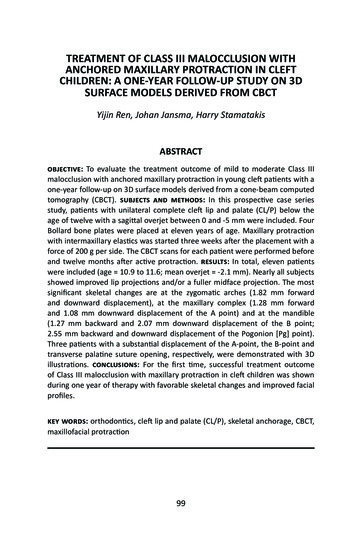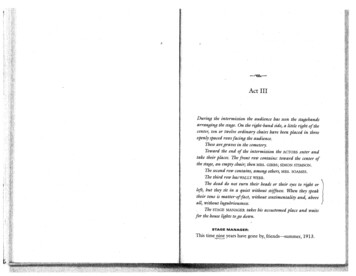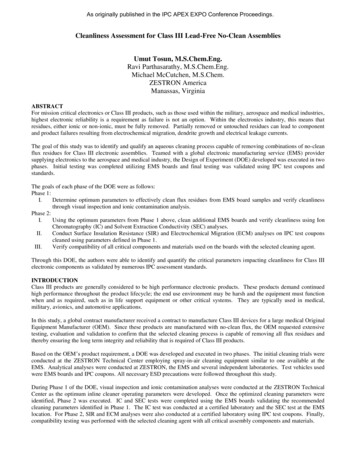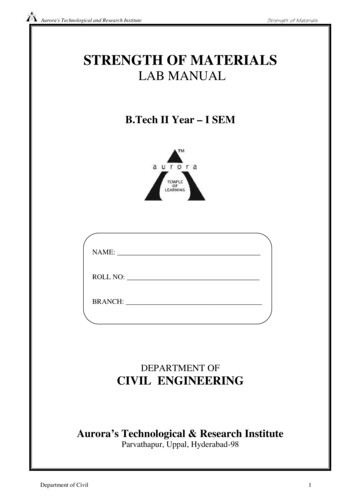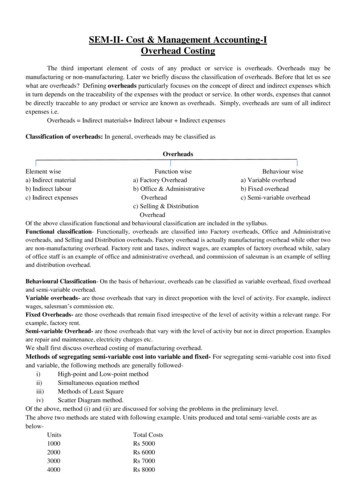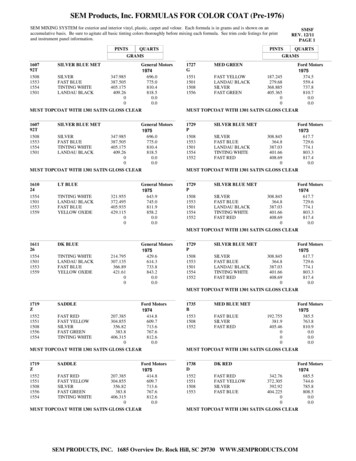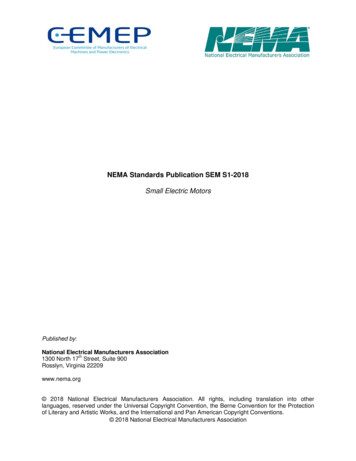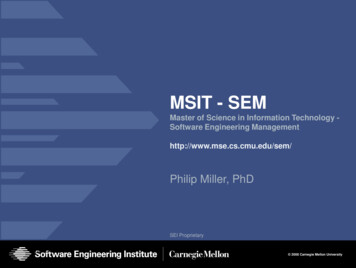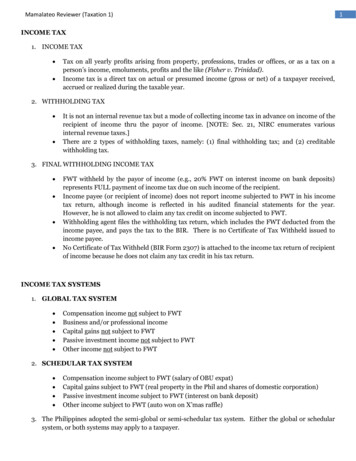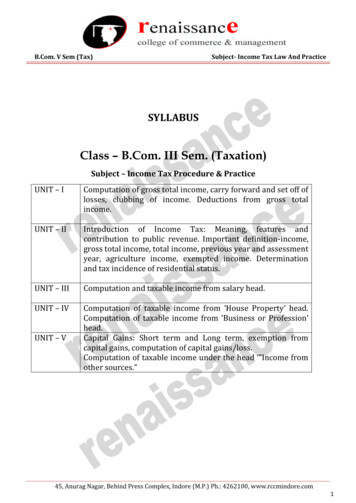
Transcription
B.Com. V Sem (Tax)Subject- Income Tax Law And PracticeSYLLABUSClass – B.Com. III Sem. (Taxation)Subject – Income Tax Procedure & PracticeUNIT – IComputation of gross total income, carry forward and set off oflosses, clubbing of income. Deductions from gross totalincome.UNIT – IIIntroduction of Income Tax: Meaning, features andcontribution to public revenue. Important definition-income,gross total income, total income, previous year and assessmentyear, agriculture income, exempted income. Determinationand tax incidence of residential status.UNIT – IIIComputation and taxable income from salary head.UNIT – IVComputation of taxable income from ‘House Property’ head.Computation of taxable income from ‘Business or Profession’head.Capital Gains: Short term and Long term, exemption fromcapital gains, computation of capital gains/loss.Computation of taxable income under the head ‘”Income fromother sources.”UNIT – V45, Anurag Nagar, Behind Press Complex, Indore (M.P.) Ph.: 4262100, www.rccmindore.com1
B.Com. V Sem (Tax)Subject- Income Tax Law And PracticeUNIT-IIndian Tax System & Income Tax LawTaxation is the major Instrument in the hand of the modern Governments to raise finance to meetexpenditure done on various public services. It is a compulsory obligation on the peoples and the paymentof which is the legal duty of the citizens. It may be on their property. Income and even it may be requiredto pay at the time of manufacturing and selling or purchasing a commodity. Tax constitute the majorsource of the government’s income.SALIENT FEATURES OF INDIAN TAX SYSTEM1. Three Tire Tax System2. Various Types of Taxes3. Important sources are in hands of the Central Government4. Composition of Tax Structure5. Modrate Rates of Taxes6. Direct and Indirect Taxes7. Public Revenue and National Income8. Local Finance9. Elasticity in State Revenue10. Integration between Central and State Revenue11. Incidence of Taxation12. Tax Evasion and CorruptionMERITS AND DEMERITS OF INDIAN TAX SYSTEMMerits1. Based on equity2. Different types of taxes3. Based on the canon of certainty4. Elasticity5. Productive tax system6. A good combination7. Follow up the maximum welfare theory8. Rapidly reduction in tax rates9. Simplification10. Wide scope of taxationDemerits or Shortcoming1. Traditional and Conservative2. Haphazard3. Regressive Character4. Inefficient to check tax Evasion5. Narrow Overage6. High Rate of Taxation7. Resources Inadequate and Inelastic8. No Uniformity9. Predominance of Indirect Taxes10. No Buoyancy11. Lack of Efficiency12. Defective Financial Allocation13. No Functional Role14. Defects on the Expenditure Front15. Corruption45, Anurag Nagar, Behind Press Complex, Indore (M.P.) Ph.: 4262100, www.rccmindore.com2
B.Com. V Sem (Tax)Subject- Income Tax Law And PracticeSUGGESTIONS FOR IMPROVEMENT1. Curtailment in tax rates2. Check on tax evasion3. Extending the tax payers numbers4. Priority to direct taxes5. Simplification of tax Laws6. Changes in public expenditure7. The regressive nature o the taxation system should be curbed8. Uniformity9. Study of Effects10. Reduction in direct tax rates11. Saving and planning habits of the people should be encouraged12. An All India Taxation Council should be institutedTax SystemThe tax is compulsory payment to the Government by taxpayer without any expectation of some specifiedreturn. While paying tax, the tax payer is not entitled to force the Government to give something to him inreturn of the sum he has paid as tax.CHARACTERISTICS OF A TAXThe conclusions which stem from the above discussion help us to point out certain characteristics of a taxwhich are generally called the elements of a tax. We may discuss the characteristics of a tax under thefollowing heads.1. A compulsory payment2. Tax is a payment to the Government by the public3. Taxes are paid by the persons and organization4. Tax is a Legal provision5. The benefit Received is not directly associated with the return of tax6. Element of sacrifice7. Payment for the common welfare8. Tax adversely affects the monetary condition of tax payer9. Taxes Increase the purchasing capacity Indirectly10. Various types of taxesOBJECTS OR AIMS OF TAXATION1. Raising Public Revenue2. Reduction in the Inequality of Wealth3. The Aim of Tax Collection is for Public Good4. Restriction on production and use of harmful goods5. Regulation of Import and ExportMERITS AND DEMERITS OF DIRECT TAXESMerits of Direct Taxes1. Equitable2. Elastic3. Civic Consciousness4. Reduce Inequalities5. Economy6. Certainty7. Absence o leakage45, Anurag Nagar, Behind Press Complex, Indore (M.P.) Ph.: 4262100, www.rccmindore.com3
B.Com. V Sem (Tax)Subject- Income Tax Law And Practice8. Educative Value or Civic ConsciousnessDemerits of Direct Taxes1. Unpopular2. Inconvenience3. More Possibility of Evasion4. Possibility of Injustice5. Narrow Based6. Not so Economical7. Discourage Savings8. Corruption9. Black MoneyINDIRECT TAXESIndirect taxes are now defined as taxes on commodities. These are customs duties such as import andexport duties on the value of goods manufactured and sales tax on goods purchased In a sense, indirectare taxes on expenditure.Due to lack of any precise definition, all taxes on commodities and services other than personalservices are treated as indirect taxes Thus, all types of sales tax, excise and customs duties are groupedas indirect taxes.Merits of Indirect Taxes1. Highly Revenue givers in Developing Countries2. Convenient3. Elastic4. Productive5. Lower Collection Costs6. Slightly Less Tax Evasion7. Can be Progressive8. Psychological Advantages to Tax payer9. Rational and Equitable Allocation of Resources10. Help in Capital Formation11. Balanced Regional Development12. Broad based13. Social WelfareDemerits of Indirect Taxes1. Regressive2. Uncertainty3. No Civic Consciousness4. Inflationary5. Tax Evasion6. Loss of Consumer Surplus7. Encourage Dishonesty and CorruptionIndian Tax StructureThere is a Union Government system in India. Administration lies in the hands of Central, States and localself governments. Functions of each government have been divided in the constitution. At the same time,their sources of finance have been specifically distributed. Description of centre-state financial relations isas under45, Anurag Nagar, Behind Press Complex, Indore (M.P.) Ph.: 4262100, www.rccmindore.com4
B.Com. V Sem (Tax)Subject- Income Tax Law And PracticeHIGHLIGHTS OF TAX STRUCTURE IN INDIAThere is a clear allocation of sources among and states under Indian constitution. Central Govt. isauthorized to impose some taxes, like Income Tax. Excise Duty, Customs etc. while State Governments mayimpose tax on sales or purchase of goods, Excise duty on intoxicants, land revenue, entertainment tax etc.A table is given below regarding various imposed by central, state and Local Governments.Central Taxes1. Income Tax2. Corporate Tax (tax onincome of companies3. Wealth tax4. Excise Duty5. Customs6. Service tax7. Expenditure tax8. Fringe Benefit Tax9. Securities transactionTax10. Commodity ExchangeTaxState Taxes1.Salestaxor(Commercial Tax)2. State Excise DutyLocal TaxesVAT 1. Octroi2. Property tax3. Road tax4. Land Revenue5. Agricultural Tax6. Entertainment Tax7. Stamp Duty8. Electric Tax9. Professional tax3. Light and water tax4. Sanitary tax5. Market tax6. License fees on shop7. Passenger tax8. Tax on hoardings9. Exhibition and fairs tax10. Entry tax10. Entry tax11. Vehicle taxMain Taxes of central Government1. INCOME TAX“Income tax is a tax on yearly taxable income of a person levied by the Central Government atprescribed rates.” Tax payers include individual, firm, company, Hindu undivided family, association ofpersons, trust etc.Taxable income means income calculated under the provisions of the Income Tax Act.Salient Feature of Income Tax1. Central Tax2. Direct Tax3. Tax on Taxable Income4. Tax Exemption limit5. Progressive rates of Tax6. Scope of Taxation7. Burden on Rich class of Persons8. Administration of Income Tax9. Distribution of Income TaxMerits of the Income Tax1. Helpful in reducing the unequal distribution of wealth2. Definiteness3. Elasticity and Productivity4. Shifting of tax burden not possible5. Just and EquitableDemerits of the Income Tax1. Bad effect on economic development45, Anurag Nagar, Behind Press Complex, Indore (M.P.) Ph.: 4262100, www.rccmindore.com5
B.Com. V Sem (Tax)Subject- Income Tax Law And Practice2. Income cannot be the only measurement of taxable capacity3. Tax evasion2. WEALTH TAXWealth tax is levied annually on the Net wealth of a person’s Wealth-tax was levied in India on therecommendations o Prof. Kaldor. It was imposed in 1957 This tax was imposed on the net wealth ofindividuals. H.U.F. and companies and was an annual tax About 900 cores are collected annually throughthis tax. The tax was considered justified on grounds of equity, economic effects and administrativeefficiency. Prof. Kaldor also pointed out that income by itself is not an adequate measure of ability to paybut a combination of income and property.Wealth tax is a tax which is levied on an annual basis on the net wealth of the assesses. It is a recurring taxand as such its rates have been kept quite low. The rate of wealth tax is only percent on excess wealthamounting to 30 Lacs 30 Lacs is exemption limit for the financial year 2014-15 and on wards.According to Central Budget 2015-16 Tax is abolished w.e.f. 2015-163. CENTRAL EXCISE DUTYMeaning of Excise Duty- Excise Duty means that duty which is imposed by Indian Govt. on manufacturingof Goods in India. Purchase or sale of Goods is not connected with it. This is an indirect tax which iscollected from the manufacture.Characteristics of Excise Duty1. It is imposed on the manufacture or production of the goods in factory2. It is imposed on the goods or things produced.3. It’s final burden falls upon the consumer.4. It is normally imposed on the ex-factory price. Permission is to be sought for taxable goods.5. Its payment to be made before removal from factory or mill.6. This tax is imposed throughout India only in one form.7. It is imposed only once on the finished goods except it is use as raw material for production ofanother goods.8. As per the rules of the excise duty, specific record has to be maintained regarding removing orshifting of the manufactured stock and the goods form the factory.Merits of Excise Duty or Importance of Excise Duty1. Major source of Governments revenue2. Psychological advantage to tax payer3. Easier to Collect4. Balanced industrial growth5. Less collection cost6. Tax evasion difficult7. Control over wasteful expenditure8. Channelize industrial growth9. Manufactures favours indirect taxes10. Record keeping easier11. No resistance by consumersDisadvantage or demerits of Excise duty1. Increases the Price of goods2. The incidence is uniform3. Reduces demand of goods4. Increases project costs5. Shields inefficient local industries45, Anurag Nagar, Behind Press Complex, Indore (M.P.) Ph.: 4262100, www.rccmindore.com6
B.Com. V Sem (Tax)Subject- Income Tax Law And Practice6. Modern technology becomes costly7. Increases smuggling/tax evasion4. CUSTOMS DUTYCustoms Duty is an Indirect tax levied by central Government on import and export of goods. CustomsDuty is applicable in foreign trade. It is an important source of revenue and instrument of regulatingimport and export of the country. Customs Duty is levied on the following two types of business1. Import Duty- When a person imports some goods from outside India, is called import and tax orduty payable on such goods called ‘Import Duty’.2. Export Duty- When a person exports some goods from India to other countries is called Export andduty payable on such goods called ‘Export Duty’.Merits of Customs Duty1. Regulating import and Export2. Protection to Domestic Industries3. Regulating the international trade competition4. Checking on wasteful expenditureDisadvantages of Customs Duty1. Increases the prices2. Increase the cost of projects3. Domestic Industries become lethargic4. Incidence of customs Duty is uniform without discrimination5. CorruptionSERVICE TAXService tax is a new tax imposed by the Central Government on taxable services Taxable service meanswhich is included in the list of taxable services under sec. 65 of the Act. The salient features of servicetax are discussed as under.1.2.3.4.5.6.7.ImpositionNumber of Taxable ServicesRate of Service TaxCollection form Service TaxApplicability of Service TaxValue of taxable service for charging Service taxExemption to small service providers6. CENTRAL SALES TAXCentral Sales Tax is applicable on sales of goods form one state to another. This tax is imposed by theCentral Govt. but is collected by the states and the amount also used by the states. This tax is imposed onthe Inter-state sale of goods. Income from this tax is divided between Central and State govts. As financecommission suggests. For example-sale of goods from a Regd. Dealer of M.P. to a dealer of Bihar is interstate sale and hence Central Sales Tax Act is applicable. Thought it is a central tax but the tax on such interstate sale will be collected and retained by M.P. Govt.Main features of the CST Act, 19561. Jurisdiction45, Anurag Nagar, Behind Press Complex, Indore (M.P.) Ph.: 4262100, www.rccmindore.com7
B.Com. V Sem (Tax)2.3.4.5.6.7.8.9.Subject- Income Tax Law And PracticeSingle point taxTax collectionImportant goodsRestrictionsRates of taxNo minimum tax-free limitProcess of tax-assessmentRight to frame rulesTAXES IMPOSED BY STATE GOVERNMENTSStates are empowered to impose various taxes according to allocation made in Indian constitution. Someimportant taxes, which are levied and collected by state governments, are discussed below.1. VALUE ADDED TAX (VAT)Value Added Tax i.e. VAT is a refined form of Sales-tax However, VAT is a multi point tax. In this systemthough tax is payable on sale of goods, but is payable only on the value addition and not on the total salevalue. VAT is applicable in may countries.VAT has been implemented from 1.4.2005 in whole India except some States Like M.P. Gujarat, Rajasthanetc. specially BJP ruled states. Now VAT is also levied in M.P. by implementing M.P. VAT Act 2006 W.e.f.1.4.06. Govt. of M.P. collects revenue from VAT about 20,000 crores.Merits or Advantages of VAT1. Not cascading effect2. Easy implementation3. Lesser cost of compliance4. Less complications5. Minimum possibilities of Litigation6. Facility of Input Tax Rebate7. Check on tax evasion8. Limited self assessment9. Payment in various stages10. Restriction on undue relaxations and exemptionsDemerits or Limitations of VAT1. Long term process2. Difficulty in set off3. Problem in refund4. Multiple rates of tax5. Accounting problems6. Conflict between VAT & CST7. Higher prices8. Unresolved problem of CST9. More formalities10. Corruption2. LAND REVENUELand Revenue is the oldest tax. It is imposed on Land owners, specially agricultural and. It is levied on thebasis of area of land or a certain percentage of crop earned. It is, popular as the name of ‘LAGAN’.Merits of Land revenue1. Certain2. Convenient45, Anurag Nagar, Behind Press Complex, Indore (M.P.) Ph.: 4262100, www.rccmindore.com8
B.Com. V Sem (Tax)Subject- Income Tax Law And PracticeDemerits of land revenue1. Inequitable2. Costly3. Inelastic3.4.5.6.7.8.9.AGRICULTURAL INCOME TAXSTATE EXCISE DUTIESENTERTAINMENT TAXSTAMP AND REGISTRATION FEESPROFESSIONAL TAXTAX ON MOTOR VEHICLESTOLL TAXLOCAL TAXES1. Property Tax2. Octroi : Local Tax on goods45, Anurag Nagar, Behind Press Complex, Indore (M.P.) Ph.: 4262100, www.rccmindore.com9
B.Com. V Sem (Tax)Subject- Income Tax Law And PracticeUNIT-IIBasic concepts of Income TaxMeaning of Income TaxIncome tax is a tax on year taxable income of a person levied by the Central Government at prescribedrates. Tax payers include individual, firm, company, Hindu undivided family, association of persons, trustetc. Taxable income means income calculated under the provisions of the Income Tax Act.1961Salient Features of Income Tax1. Central Tax2. Direct Tax3. Tax on Taxable Income4. Progressive rates of Tax5. Scope of Taxation not only with individual but also with firm, company, HUF, Trust & Co-OperativeSocieties6. Tax Exemption limit7. Burden on Rich class persons8. Separate Administration9. Distribution of Tax between Central and State Government10. It is largest source of revenue.11. Tax for country welfare12. History of income Tax in India is about 150 years old.13. Control on Income by Income tax14. Beginning of Income Tax by sir James Wilson in 1860 in India.Income [Section 2(24)]Though ‘Income’ is a very important word for the Income Tax Act but no precious definition of the word“Income” is attempted under the Income Tax Act, 1961. The term “Income”, in the context of the Act, ininclusive. The narrion given in Sub-Section (24) of Section 2 of the Act enumerates certain items, includingthose which cannot ordinarily be considered as income but are treated satutorily as such.Definition of Income [Section 2(24)]Income Includes:1. Profit and gains;2. Dividend;3. Voluntary contributions received by a trust.4. The value of a perquisite o profit in lieu of salary.5. Any special allowance or benefit other than perquisites included under 4.6. Any allowance granted to the assessee either to meet his personal expenses at the place where theduties of his office7. The value of any benefit or perquisite obtained from a company.8. Any compensation9. Profit on sale of License10. Cash assistance received11. Any interest, salary, bonus, commission/remunerations12. Profit/gain of mutual or co-operative insurance co.13. Capital gain arising from transfer of capital gain14. Any sum received under a key man insurance police.Agricultural Income [Section 2 (1A)]Definition of Agriculture IncomeSec. 2(1A) defines “agricultural income” to means –45, Anurag Nagar, Behind Press Complex, Indore (M.P.) Ph.: 4262100, www.rccmindore.com10
B.Com. V Sem (Tax)(A)Subject- Income Tax Law And Practiceany rent or revenue derived from land which is situated in India and is used for agriculturalpurposes,any income derived from such land by agriculture or by the process employed to render theproduce fit for the market or by sale of such produce by a cultivator or receiver of rent in kind,Any income derived from any building provided the following conditions are satisfied (i) TheBuilding is immediate vicinity of the agriculture land (ii) it is occupied by the cultivator orreceived of rent or revenue (iii) It is used as a dwelling house or store house/out house. (iv)The land is assessed to land revenue or a local rate.Any income derived from saplings/seedling grown in a nursery shall be deemed to beagricultural income.(B)(C)(D)S.No.12345Partly Agricultural Income Shown by ChartPartly Agricultural IncomeAgriculturalNon AgriculturalIncomeIncomeGrowing & manufacturing tea in India60%40%Growing & cured coffee in India by the75%25%sellerSale of Coffee grown, cured, roasted and60%40%groundedSale of centrifuged latex or cenex65%35%manufactured from rubberOther Agricultural produce grown by theMarket value of Remaining Businessmanufacturer and used for own product.agriculturalincome will beproduce usedtaxable.in productionIncome connected with land but not agricultural income –1. Profit earned on purchasing the standing crop.2. Income from mines3. Income from self grown grass, trees/bamboos4. Divided from a company engaged in Agricultural5. Income from warehouses and godowns.6. Income from land used for brick making7. Income from supply of water for irrigation purposes.8. Remuneration for managing agricultural property.9. Income from dairying.10. Interest accrued on promissory notes executed for arrears of rent.Agricultural Income and Tax Liability –Though agricultural income is exempt and it is not included in computation of total income of an assesseebut from tax calculation point of view it is added to total income. The agricultural income is integratedwith non-agricultural income in those cases where assessee has both incomes. Such integration is doneonly in the case of individual, HUF, AOP/BOI and Artificial juridical person.Condition for Integration When the following two conditions are satisfied(i)Non agricultural income of the assessee exceeds the maximum exemption limit which for theassessment year 2015-16 is Rs. 2.5 lakh in the case of an individual, Women and HUF in case ofSenior citizen it will be Rs. 3,00,000 and Super senior citizen Rs. 5,00,000 instead of Rs.2,50,000/-.(ii)Net agricultural income exceed Rs. 5,00045, Anurag Nagar, Behind Press Complex, Indore (M.P.) Ph.: 4262100, www.rccmindore.com11
B.Com. V Sem (Tax)Subject- Income Tax Law And PracticeProcedure for computation of Tax-payable an non-agricultural income after Integration1. Aggregate the Agricultural income with non Agricultural income and determine the tax payable onsuch amount.2. Aggregate the Agricultural income with basis exemption limit and determine the tax payable onsuch amount.3. The difference between the tax computed in step (a) and step (b) will be the tax payable in respectof non-agricultural income.CASUAL INCOMECausal Income means such income the receipt of which is accidental and without any stipulation. It isthe nature of an unexpected windfall.Though causal income is fully taxable but it is necessary to clear this meaning from the following pointof view –1. Causal income like lottery, race income are taxable at special rate of 30%2. Causal income cannot be set off against other causal income as well as casual income cannot beused for setting off loss of other head.4. ASSESSMENT YEAR : (2015-2016)It means the period of twelve months commencing on 1st of April every year. In other words period of12 months – 1st April to 31st March is called assessment year.5. PREVIOUS YEAR (Section 3)(2014-2015)Previous year means the financial year immediately preceding the assessment year e.g. for theassessment year 2015-2016 previous year will commence on 1st of April, 2014 and end on 31st March,2015. Previous year for income tax purposes will be financial year which ends on 31 st of March,however the assessee can close his books of accounts on other date e.g. an assessee may maintainbooks of accounts on calendar year basis but his previous year, for Income Tax purpose, will befinancial year and not the calendar year. This uniform previous year has to be followed for all sourcesof income.Important points in relation to previous year: Under the following situation the previous year wouldbe 1. Where a different accounting year is followed2. Previous year in case of newly set up business3. In case of newly created source of incomeException to the rule of Previous Year:These exceptions are:1. Shipping business income of non-resident ship-owners2. In case of persons leaving India3. In case of persons who are likely to transfer their assets to avoid tax4. In case of discontinued businessPERSON [SECTION-2 (31)]The term ‘person’ includes:(1)An individual(2)A Hindu undivided family(3)A Company;(4)A Firm;(5)An association of persons or a body of individuals, whether incorporated or not;(6)A local authority like Municipalities, Panchayats, Cantonment Boards, Port Trusts etc.45, Anurag Nagar, Behind Press Complex, Indore (M.P.) Ph.: 4262100, www.rccmindore.com12
B.Com. V Sem (Tax)(7)Subject- Income Tax Law And PracticeEvery artificial juridical person Like Life Insurance Corporation, University etc.ASSESSEE [SECTION-2 (7)]In simple word, An Assessee is a person who is liable to pay any sum under Income Tax Act or in respect Inrespect of whom the proceeding have been initiated under this Act.The word ‘assessee’ has been defined in Section 2(7) of the Act according to which assesseemeans a person by whom any tax or any other sum of money is payable under the Act and includes –(a) Every person:(i)Who is liable to pay any tax; or(ii)Who is liable to pay any other sum of money under this Act (e.g. interest, penalty, etc); or(iii)In respect of whom any proceeding under this Act has been taken for the assessment of theincome; or(iv)In respect of whom any proceeding under this Act has been taken for the assessment of theincome of any other person in respect of which he is assessable; or(v)In respect of whom any proceeding under this Act has been taken for the assessment for theloss sustained by him or by such other person; or(vi)In respect of whom any proceeding under this Act has been taken for the amount of refund dueto him or to such other person;(b) A Deemed Assessee:A person who is liable to pay tax not only on his own income but on the income of any anotherperson. Deemed assesses includes legal representative, agent of non resident, guardian or manager ofan infant and lunatic, trustees and administrators etc.(c) Who is deemed to be an assessee in default?A person is said to be an assessee in default if he fails to comply with the duties imposed upon himunder the Income tax Act.GROSS TOTAL INCOMEGross Total Income means aggregate amount of taxable income computed under five heads of income i.e.salaries, house property, business & profession, capital gains and other sources. In other words, GrossTotal Income means total income computed in accordance with the provisions of the Act before makingany deduction under sections 80C to 80U.In Simple words, the aggregate amount of the following heads of income is called Gross Total Income –(i)Salaries (Cash receipts and perquisites from the employer),(ii)Income from House Property (Rental income)(iii)Profits an Gains of Business or Profession,(iv)Capital Gains from transfer of movable and immovable assets,(v)Income from other Sources i.e. interest, royalty, lottery etc.TOTAL INCOMEThe following are the current rates of taxation for an individual, Hindu, Undivided Family, firm, companyand co-operative society for the assessment year 2015-16.Tax Rates –BASIS OF CHARGE (TAX RATE)Applicable tax rates for the AssessmentYear 2015-16 (Previous year 2014-2015)are as follows –1. Tax rates applicable on individual and HUF (less than 60 years)–IncomeTax RateOn First Rs. 250000NIL45, Anurag Nagar, Behind Press Complex, Indore (M.P.) Ph.: 4262100, www.rccmindore.com13
B.Com. V Sem (Tax)Subject- Income Tax Law And PracticeOn Next Rs. 250001 to 5,00,000On Next Rs. 5,00,001 to 1000000On above 10,00,00010%20%30%2. Resident senior citizen Assessee (Whose age is 60 year or more but less than 80 years) Male orFemaleIncomeTax RateOn First Rs. 3,00,000On Next Rs. 3,00,001 to 5,00,00010%On Next Rs. 5,00,001 to 10,00,00020%On above 10,00,00030%3. Super Senior Citizen Assessee (80 years or more)IncomeOn First Rs. 5,00,000On Next Rs. 5,00,001 to 10,00,000On above 10,00,000Tax Rate20%30%4. Partnership firm - 30% flat Rate on Income of firm.5. Domestic Company –Domestic Company 30% flat rate on income if income is more than Rs. 1 Crorethen 5% Surcharge & 10% surcharge in case exceed of 10 Crore is also applicable on tax payable.6. Foreign Company –Foreign Company 40% flat rate on income if income is more than Rs. 1 Crore then5% Surcharge & 10% surcharge in case exceed of 10 Crore is also applicable on tax payable.7. Co-operative Society –IncomeTax RateOn First Rs. 10,00010%On Next Rs. 10,00020%On remaining balance30%8. Tax Rate on special incomea. Long term capital gain20% (Flat)b. Short term capital gain (U/s 111A)15% (Flat)c. Income on lottery, horse race, Cross word Puzzle etc. 30% (Flat)9. Education Cess – 3% Education Cess is applicable on taxable Income of all type of assessee but in caseof company education cess is applicable after adding of surcharge (if any).INCOME WHICH DOES NOT FROM PART OF TOTAL INCOMEEXEMPTED INCOMESection -10 of Income Tax Act laye down income which is totally or partially exempted from taxA. EXEMPTED INCOME FOR ALL ASSESSES1. Agricultural Income Sec. 10(1)2. Share of income from partnership firm Sec. 10 (2A)3. Share of HUF Income Sec. 10(2)45, Anurag Nagar, Behind Press Complex, Indore (M.P.) Ph.: 4262100, www.rccmindore.com14
B.Com. V Sem (Tax)Subject- Income Tax Law And olarships – Sec.10(16)Income as divided Sec. 10 (34 & 35)Capital gain on transfer of u/s 64 (Sec. 10 (33)Allowance of M.P./MLA Sec. 10 (17)Award / reward Sec. 10 (17A)Pension to gallantry award winner Sec. 10(18)Family Pension received by the family members of armed forces Sec. 10(19).Capital gain on compulsory acquision of urban Agriculture land Sec. 10(37)Interest on notified Government Securities Sec. 10(15)Income of minor child which is clubbed Sec. 10(32) [Up to 1,500/- per child]Compensation under Bhopal Gas Leak Disaster Sec. 10(10BB)Income of subsidy from Tea Board Sec. 10(30)Income of schedule Tribe members Sec. 10(26)Amount received under a life Insurance Policy Sec. 10(26)Income of subsidy from Rubber Board/Coffee Board /spices board / any other notified Board Sec.10(31)19. Income from Sukanya Samriddhi Account – Sec. 10(11)A.B. EXEMPTED INCOME FOR EMPLOYEESHouse Rent Exempted upto a certain limit Sec.10(13A)a) Gratuity, Commuted pension, leave encashment to Government employees is fully exempted Sec.10(10)b) Gratuity, leave encashment, commuted pension to non-government, employees is exempted upto a certain limit.a) Commutation of pension received by an employees pension for government employees, fullyexempted Sec. 10(10A)b) Pension for non-government employee exempted upto certain limit.Leave travel concession in India Sec. 10(5)1.2.3.4.5.6.7.8.9.10.11.12.13.Actual Amount Received orAmount Prescribed orWhich ever is lessAmount Actual SpentAmount received as leave encashment on retirement Sec.-10 (10AA)a) Central/State Government Employee – Fully Exemptedb) Other Employee exempted upto certain limitCompensation on retrenchment Exempted upto certain limit.Sec.10(10 B)Allowance or perquisite outside India Sec 10(7)Allowance/perq
Customs Duty is levied on the following two types of business B.Com. V Sem (Tax) Subject- Income Tax Law And Practice 45, Anurag Nagar, Behind Pres

